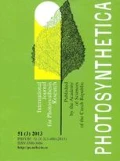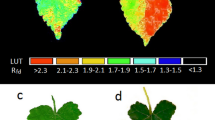Abstract
This contribution is a practical guide to the measurement of the different chlorophyll (Chl) fluorescence parameters and gives examples of their development under high-irradiance stress. From the Chl fluorescence induction kinetics upon irradiation of dark-adapted leaves, measured with the PAM fluorometer, various Chl fluorescence parameters, ratios, and quenching coefficients can be determined, which provide information on the functionality of the photosystem 2 (PS2) and the photosynthetic apparatus. These are the parameters Fv, Fm, F0, Fm′, Fv′, NF, and ΔF, the Chl fluorescence ratios Fv/Fm, Fv/F0, ΔF/Fm′, as well as the photochemical (qP) and non-photochemical quenching coefficients (qN, qCN, and NPQ). qN consists of three components (qN = qE + qT + qI), the contribution of which can be determined via Chl fluorescence relaxation kinetics measured in the dark period after the induction kinetics. The above Chl fluorescence parameters and ratios, many of which are measured in the dark-adapted state of leaves, primarily provide information on the functionality of PS2. In fully developed green and dark-green leaves these Chl fluorescence parameters, measured at the upper adaxial leaf side, only reflect the Chl fluorescence of a small portion of the leaf chloroplasts of the green palisade parenchyma cells at the upper outer leaf half. Thus, PAM fluorometer measurements have to be performed at both leaf sides to obtain information on all chloroplasts of the whole leaf. Combined high irradiance (HI) and heat stress, applied at the upper leaf side, strongly reduced the quantum yield of the photochemical energy conversion at the upper leaf half to nearly zero, whereas the Chl fluorescence signals measured at the lower leaf side were not or only little affected. During this HL-stress treatment, qN, qCN, and NPQ increased in both leaf sides, but to a much higher extent at the lower compared to the upper leaf side. qN was the best indicator for non-photochemical quenching even during a stronger HL-stress, whereas qCN and NPQ decreased with progressive stress even though non-photochemical quenching still continued. It is strongly recommended to determine, in addition to the classical fluorescence parameters, via the PAM fluorometer also the Chl fluorescence decrease ratio RFd (Fd/Fs), which, when measured at saturation irradiance is directly correlated to the net CO2 assimilation rate (P N) of leaves. This RFd-ratio can be determined from the Chl fluorescence induction kinetics measured with the PAM fluorometer using continuous saturating light (cSL) during 4–5 min. As the RFd-values are fast measurable indicators correlating with the photosynthetic activity of whole leaves, they should always be determined via the PAM fluorometer parallel to the other Chl fluorescence coefficients and ratios.
Similar content being viewed by others
Abbreviations
- AL:
-
“actinic light”
- Car:
-
carotenoids
- Chl:
-
chlorophyll
- cSL:
-
continuous saturating light
- F0 :
-
ground fluorescence in the dark-adapted state
- F0':
-
ground fluorescence in the light-adapted state
- Fd :
-
fluorescence decrease from Fp to Fs
- Fm :
-
maximum Chl fluorescence at a saturating radiation pulse in the dark-adapted state
- Fm′:
-
maximum Chl flurorescence in the light-adapted state
- Fp :
-
maximum Chl fluorescence at a non-saturating light pulse in the dark-adapted state
- Fs :
-
steady state Chl fluorescence
- ΔF:
-
fluorescence spike at the end of the induction kinetic on top of the AL-induced kinetics (Fm' - F)
- Fd/Fs :
-
ratio of Chl fluorescence decrease Fd to steady state Chl fluorescence Fs
- HI:
-
high irradiance (high light)
- ML:
-
measuring light
- NF:
-
Chl fluorescence parameter related to non-photochemical quenching (Fm - Fm')
- P N :
-
net CO2 assimilation rate
- PAR:
-
photosynthetically active radiation
- PPFD:
-
photosynthetic photon flux density
- RFd :
-
variable chlorophyll fluorescence decrease ratio
- SL:
-
saturating light
References
Babani, F., Lichtenthaler, H.K.: Light-induced and age-dependent development of chloroplasts in etiolated barley leaves as visualized by determination of photosynthetic pigments, CO2 assimilation rates and different kinds of chlorophyll fluorescence ratios. — J. Plant Physiol. 148: 555–566, 1996.
Bilger, W., Bjorkman, O.: Role of the xanthophyll cycle in photoprotection elucidated by measurements of light-induced absorbance changes, fluorescence and photosynthesis in leaves of Hedera canariensis. — Photosynth. Res. 25: 173–185, 1990.
Bilger, W., Schreiber, U.: Energy-dependent quenching of dark-level chlorophyll fluorescence in intact leaves.-Photosynth. Res. 10: 303–308, 1986.
Buschmann, C.: Variation of the quenching of chlorophyll fluorescence under different intensities of the actinic light in wild-type plants of tobacco and in an aurea mutant deficient of light harvesting complex. — J. Plant Physiol. 145: 245–252, 1995.
Buschmann, C.: Photochemical and non-photochemical quenching coefficients of the chlorophyll fluorescence: comparison of variation and limits. — Photosynthetica 37: 217–224, 1999.
Buschmann, C., Lichtenthaler H.K.: Principles and characteristics of multi-colour fluore scence imaging of plants.-J. Plant Physiol. 152: 297–314, 1998.
Buschmann, C., Schrey, H.: Fluorescence induction kinetics of green and etiolated leaves by recording the complete in-vivo emission spectra. — Photosynth. Res. 1: 233–241, 1981.
Demmig-Adams, B., Winter, K., Kruger, A., Czygan, F.-C.: Light response of CO2 assimilation, dissipation of excess excitation energy, and zeaxanthin content of sun and shade leaves. — Plant Physiol. 90: 881–886, 1989.
Fork, D.C., Satoh, K.: The control by state transitions of the distribution of excitation energy in photosynthesis. — Annu. Rev. Plant Physiol. 37: 335–361, 1986.
Franck, F., Juneau, P., Popovic, R.: Resolution of the Photosystem I and Photosystem II contributions to chlorophyll fluorescence of intact leaves at room temperature. — Biochim. biophys. Acta 1556: 239–246, 2002.
Genty, B., Briantais, J.-M., Baker, N.R.: The relationship between the quantum yield of the photosynthetic electron transport and quenching of chlorophyll fluorescence. — Biochim. biophys. Acta 990: 87–92, 1989.
Gitelson, A.A., Buschmann, C., Lichtenthaler, H.K.: Leaf chlorophyll fluorescence corrected for reabsorption by means of absorption and reflectance measurements. — J. Plant Physiol. 152: 283–296, 1998.
Gitelson, A.A., Buschmann, C., Lichtenthaler, H.K.: The chlorophyll fluorescence ratio F735/F700 as an accurate measure of the chlorophyll content in plants. — Remote Sens. Environ. 69: 296–302, 1999.
Govindjee.: Chlorophyll a fluorescence: a bit of basics and history. — In: Papageorgiou, G.C., Govindjee (ed.): Chlorophyll Fluorescence: A Signature of Photosynthesis. Pp. 1–42. — Springer, Dordrecht 2004.
Haitz, M., Lichtenthaler, H.K.: The measurement of RFd-values as plant vitality indices with the portable field fluorometer and the PAM-fluorometer. — In: Lichtenthaler, H.K. (ed.): Applications of Chlorophyll Fluorescence. Pp. 249–254. Kluwer Academic Publishers, Dordrecht-Boston-London 1988.
Haldrup, A., Jensen, P.E., Lunde, C., Scheller, H.V.: Balance of power: a view of the mechanism of photosynthetic state transitions. — Trends Plant Sci. 6: 301–305, 2001.
Kautsky, H., Hirsch, A.: Neue Versuche zur Kohlensaureassimilation. — Naturwissenschaften 19: 964, 1931.
Kitajima, M., Butler, W.L.: Quenching of chlorophyll fluorescence and primary photochemistry in chloroplasts by dibromothymoquinone. — Biochim. biophys. Acta 376: 105–115, 1975.
Lichtenthaler, H.K.: Chlorophylls and carotenoids-the pigments of photosynthetic biomembranes. — In: Colowick, S.P., Kaplan, N.O. (ed.): Methods in Enzymology. Vol. 148. Pp. 350–382. Academic Press, San Diego-New York-Berkeley-Boston-London-Sydney-Tokyo-Toronto 1987.
Lichtenthaler, H.K.: The Kautsky effect: 60 years of chlorophyll fluorescence induction kinetics.-Photosynthetica 27: 45–55, 1992.
Lichtenthaler, H.K., Babani, F.: Light adaptation and senescence of the photosynthetic apparatus: changes in pigment composition, chlorophyll fluorescence parameters and photosynthetic activity. — In: Papageorgiou, G.C., Govindjee (ed.): Chlorophyll Fluorescence: A Signature of Photosynthesis. Pp. 713–736. Springer, Dordrecht 2004.
Lichtenthaler, H.K., Burgstahler, R., Buschmann, C., Meier, D., Prenzel, U., Schonthal, A.: Effect of high light and high light stress on composition, function and structure of the photosynthetic apparatus. — In: Marcelle, R., Clijsters, H., van Poucke, M. (ed.): Effects of Stress on Photosynthesis. Pp. 353–370. Martinus Nijhoff/Dr W. Junk Publ., The Hague-Boston-London 1982.
Lichtenthaler, H.K., Burkart, S.: Photosynthesis and high light stress. — Bulg. J. Plant Physiol. 25: 3–16, 1999.
Lichtenthaler, H.K., Burkart, S., Schindler, C., Stober, F.: Changes in photosynthetic pigments and in vivo chlorophyll fluorescence parameters under photoinhibitory growth conditions. — Photosynthetica 27: 343–353, 1992.
Lichtenthaler, H.K., Buschmann, C.: Photooxidative changes in pigment composition and photosynthetic activity of air-polluted spruce needles (Picea abies L.). — In: Sybesma, C. (ed.): Advances in Photosynthesis Research. Vol. IV. Pp. 245–250. Martinus Nijhoff/Dr. W. Junk Publ., The Hague-Boston-Lancaster 1984.
Lichtenthaler, H.K., Buschmann, C.: Chlorophylls and carotenoids-measurement and characterisation by UV-VIS.-Current Protocols in Food Analytical Chemistry (CPFA), (Supplement 1), F4.3.1–F4.3.8. John Wiley, New York 2001.
Lichtenthaler, H.K., Langsdorf, G., Lenk, S., Buschmann, C.: Chlorophyll fluorescence imaging of photosynthetic activity with the flash-lamp fluorescence imaging system. — Photosynthetica 43: 355–369, 2005.
Lichtenthaler, H.K., Miehe, J.A.: Fluorescence imaging as a diagnostic tool for plant stress. — Trends Plant Sci. 2: 316–320, 1997.
Lichtenthaler, H.K., Rinderle, U.: The role of chlorophyll fluorescence in the detection of stress conditions in plants. — CRC crit. Rev. anal. Chem. 19: S29–S85, 1988a.
Lichtenthaler, H.K., Rinderle, U.: Chlorophyll fluorescence spectra of leaves as induced by blue light and red laser light. — In: Proceed. 4th Int. Colloq. Spectral Signatures of Objects in Remote Sensing. Pp. 251–254. ESA Publications Division, Noordwijk 1988b.
Papageorgiou, G.C., Govindjee (ed.): Chlorophyll Fluorescence: A Signature of Photosynthesis. — Springer, Dordrecht 2004.
Pfundel, E.: Estimating the contribution of Photosystem I to total leaf chlorophyll fluorescence. — Photosynth. Res. 56: 185–195, 1998.
Quick, W.P., Stitt, M.: An examination of factors contributing to non-photochemical quenching of chlorophyll fluorescence in barley leaves. — Biochim. biophys. Acta 977: 287–296, 1989.
Rohacek, K.: Chlorophyll fluorescence parameters: the definitions, photosynthetic meaning, and mutual relationships. — Photosynthetica 40: 13–29, 2002.
Ruban, A.V., Horton, P.: Regulation of non-photochemical quenching of chlorophyll fluorescence in plants. — Aust. J. Plant Physiol. 22: 221–230, 1995.
Schindler, C., Lichtenthaler, H.K.: Is there a correlation between light-induced zeaxanthin accumulation and quenching of variable chlorophyll a fluorescence? — Plant Physiol. Biochem. 32: 813–823, 1994.
Schindler, C., Lichtenthaler, H.K.: Photosynthetic CO2 assimilation, chlorophyll fluorescence and zeaxanthin accumulation in field grown maple trees in the course of a sunny and a cloudy day. — J. Plant Physiol. 148: 399–412, 1996.
Schreiber, U., Schliwa, U., Bilger, W.: Continuous recording of photochemical and non-photochemical chlorophyll fluorescence quenching with a new type of modulation fluorometer. — Photosynth. Res. 10: 51–62, 1986.
van Kooten, O., Snel, J.F.H.: The use of chlorophyll fluorescence nomenclature in plant stress physiology.-Photosynth. Res. 25: 147–150, 1990.
Walters, R.G., Horton, P.: Resolution of components of nonphotochemical chlorophyll fluorescence quenching in barley leaves. — Photosynth. Res. 27: 121–133, 1991.
Author information
Authors and Affiliations
Corresponding author
Rights and permissions
About this article
Cite this article
Lichtenthaler, H.K., Buschmann, C. & Knapp, M. How to correctly determine the different chlorophyll fluorescence parameters and the chlorophyll fluorescence decrease ratio RFd of leaves with the PAM fluorometer. Photosynthetica 43, 379–393 (2005). https://doi.org/10.1007/s11099-005-0062-6
Received:
Accepted:
Issue Date:
DOI: https://doi.org/10.1007/s11099-005-0062-6



